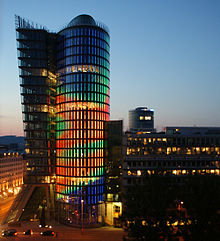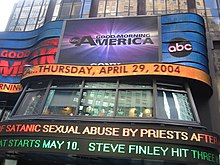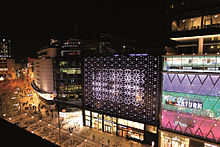Media facade


A media facade is a flat, animated light installation, typically on large city business and cultural buildings, which is used for advertising, information or art.
Media facades are all facades that, in addition to the building physics and design, generate added value through media exchange, the transport of information or visual stimuli.
history
With the widespread introduction of electricity at the beginning of the 20th century , illuminated advertising experienced a heyday. Even before the First World War , light bulb panels were installed on house facades and on roofs in Berlin . As early as 1910, neon tubes and Moore lights were also used . There was an accumulation of these systems in city squares in metropolises such as Potsdamer Platz , Piccadilly Circus or Times Square , the high frequency of which was expected to provide optimal range.
In the inter-war period , in these places, as well as at press houses and train stations, traveling writing systems were used, which, in addition to advertising, presented daily short news on sometimes considerable areas. The staging of architecture with installations such as Berlin in Light also attracted public attention on the occasion of the Berliner Festwochen 1928; the concept of light architecture was coined. Architects of classical modernism , including Erich Mendelsohn and Vasily Luckhardt dealt with the integration of advertising and planning the nocturnal effect of building facades, the growing proportion of glass favored the intended effects. Even the biggest bright tower in Europe at the European House of Otto Firle and light show palaces such as the Titania Palast in this direction that the building of the Coöperatie De Volharding culminated whose facade almost entirely in glass blocks , windows and backlit Opalglasfelder was dissolved on which exchange letters were mounted . However, further development of these promising approaches was thwarted by the global economic crisis , the subsequent war economy and the blackout in the bombing war . In 1936, Oskar Nitschke created another design for a Maison de la Publicité , the facade of which already included moving image projections, but was unfortunately no longer implemented. The 10-line cell grid large screen with 10,000 incandescent lamps on about 4 m² for displaying television images , which was presented by August Karolus at the radio exhibition in the same year , was also no longer used due to the outbreak of the Second World War .
The grid facades of the post-war international style office buildings were particularly suitable for illuminated advertising using regular lighting: an example of this is the SKF high-rise in Schweinfurt . At the end of work, blue roller blinds were lowered on certain windows, which were illuminated by fluorescent tubes on the lintels and thus displayed the company logo in a size of 25x36 m. In other buildings it was possible to switch the room lighting of the offices centrally from the night porter's box; From around 1960, the company logo could also be displayed on the Phoenix-Rheinrohr AG administration building in Düsseldorf with 138 blue fluorescent tubes in the window reveals of 13 floors.
This approach was finally exhausted by the Blinkenlights project at the teacher's house , where the audience could perform their own animation sequences and - regardless of the relatively low resolution of only 8x18 "pixels" - even play the classic video game Pong .
In 1977, Spectacolor Inc., founded by George N. Stonbely, installed the first full-color, computer- controlled large advertising space at the New York Times publishing building , One Times Square , which led to a paradigm shift in that it was now possible to market airtime instead of advertising space. As a result, more than 100 such systems were installed in Times Square and elsewhere, including the Eastman Kodak Kodarama display; this was seen as a return of the advertising industry to the city centers. Since 1982, as part of a media art initiative of the Public Art Fund , the Truisms of the concept artist Jenny Holzer have been included in the ongoing advertising animations on the Spectacolor Light Board in Times Square .
In Berlin, around 1989 , Gruner & Jahr operated the short-lived Avnet screen at Ku'damm-Eck with a similar objective . Its unique selling point was its peculiar display technology.
Since the turn of the millennium, there has been a boom in media facades in Europe - due to advances in both lighting technology ( LED ) and control ( KNX , Arduino ): the spectrum ranges from media art projects to those with a focus on emphasis the architecture to advertising-oriented large-screen video displays. Corporate identity strategists and city marketing officers attribute an identity-creating effect to them.
In 2008, 19 projects were presented for the first time at the Medienfassaden-Festival Berlin ; since then the Media Architecture Institute has organized a biennial on the subject.
technology
Initially, the updating of the displayed content was limited to the manual exchange of letters. Corresponding building-integrated grid panels were used in particular for cinema advertising. Motorized transparencies were also suitable in this situation. In the case of the traveling writing systems, endless strips with embossed letters were drawn past spring contacts, which closed the circuit of the corresponding lamp by immersing them in a mercury bath as soon as they were lifted by the contour of a letter; later punched tape was also used.
The dynamic control of the systems was carried out up to the 1970s via stepping units or relay groups borrowed from switching technology . Since then, these have been replaced by computers with user interfaces of increasing convenience.
Beginning with the Sony Jumbotron , large-screen video displays have been developed since the early 1980s, which in the absence of blue-light LEDs initially consisted of modules of special cathode ray tubes , each of which could display 2 to 16 pixels. These displays had diagonals from 9 to a maximum of 35 meters with a resolution of 240 × 192 pixels. Due to the high cost, they were preferably installed in stadiums, such as the SkyDome Toronto . Since the introduction of inexpensive LED and, more recently, OLED lamps with high luminous intensity , such systems can now also be used on facades.
Recently there is also wire mesh with braided LEDs.
Tendencies
- growing play area
- increasing frame rate
- falling energy consumption
- Interactive applications
- Standardization of protocols for building automation
- Inexpensive availability of energy-efficient light sources
- Open source software / hardware for the control
- falling effort for the creation of the content
Content
Depending on the system design and technology used, media facades are suitable for
- abstract light and color effects
- Marquee
- Pixel images
- Video
- Interactivity
The technical restrictions in terms of color, resolution and frame rate are also perceived as a distinct stylistic quality, especially if the objective of the system is more towards light art than advertising.
Executed projects
- 1928: Coöperatie De Volharding in The Hague , Grote Markt 22 (architect Jan Buijs ) location
- 1962: Logo of Phoenix-Rheinrohr AG on the Dreischeibenhaus location
- 1963: SKF's German headquarters building in Schweinfurt Lage
- 1977-1990: Spectacolor light board on the north facade of One Times Square , New York City (red, white, blue and green 60 8,000 watt incandescent m² to 75, 1990 replaced by Sony Jumbotron) location
- 1988-1990: Avnet screen ( louvers advertising space ) at the old Berlin Ku'damm-Eck (m² 300, display means more than 100,000 rotatably mounted plastic cubes, destroyed by fire in 1990) Location
- 1999: Marnix Monumental Interactive Matrix in Brussels (768 RGBW Power Strips on 2000 m², client: ING Groep , architect: Gordon Bunshaft , conception: Magic Monkey ) Location
- 2001–2005: Blinkenlights project at the teacher's house in Berlin , Alexanderplatz Lage
- : 2002 Post Tower in Bonn (1925 lights with three high-voltage fluorescent tubes in red, yellow and blue, Design: Light Technology LTW plant) location
- 2002: Internet art facade at the House of Communication in Munich, Brienner Strasse (76 panels of 74x92 cm with RGB HV neon tubes, client: Serviceplan Group for innovative communication , architect: Otto Hartmann , execution: Neon Härter, Fischer Licht & Metall) location
- 2003: BIX media facade on the Kunsthaus Graz (from 930 standard circular 40 watt fluorescent tubes spread over 900 m², Architect: Peter Cook , Execution: realities: united ) location
- 2003-2004: Galleria Fashion Store in Seoul (4,300 sandblasted glass laminate panes with embedded LED to 900 m², architect: UNStudio , Design: Arup Ass.) Location
- 2004: Chanel Ginza Building in Tokyo (laminated glass facade with embedded liquid crystals, architect Peter Marino ) location
- : 2005 UNIQA Tower in Vienna (approximately 160,000 LED sqm to about 7,000, the system operates on video component base with 25 fps concept. LichtKunstLicht ) location
- 2005-2007: SPOTS at the entrance building of Park colonnade at Potsdamer Platz as a project of the 10th Architecture Biennale (1800 in a matrix on 1,350 sqm located annular fluorescent tubes, individually controllable version: realities: united) location
- 2006: Tour Rogier in Brussels, formerly (equipped 4200 windows, each with 12 LED lamps) Dexia Tower location
- 2008: Museion in Bolzano (Architects: KSV Krüger Schuberth Vandreike, Execution: Lichtvision Design) Location
- 2008: GreenPix Zero Energy Media Wall at the Xicui Entertainment Complex in Beijing (2292 RGB LED on 2,200 m², architect: Simone Giostra , execution: Arup) location
- 2008: administrative building of the PSD Bank Westfalen-Lippe in Münster (big screen with 220,000 LED) location
- 2008–2010: Dortmunder U (Gerber Architects, including animation "Flying Pictures" by Adolf Winkelmann ) location
- 2009: Bayer media sculpture at Bayer tower (5632905 LED m² to 18,000, Execution: ag 4 MEDIAFACADE demolished due to instability of the LED 2012) Location
- 2010: Zeilgalerie in Frankfurt am Main ( video wall of 260 m² with 14,000 LED version: 3deluxe , demolished 2016) Location
- 2010–2012: Hypercube in the Skolkowo Innovation Center in Moscow , (architect Boris Bernaskoni , execution: Haver & Boecker) location
- 2015: St. Pauli clubhouse in Hamburg , Spielbudenplatz (approx. 700 m², design: Onlyglass, Urbanscreen) location
- 2016: Centro de Creación Contemporánea de Andalucía (C3A) in Córdoba (Architects Nieto Sobejano Arquitectos , execution: realities: united) Location
- 2016: Platform hall of Chemnitz main station with LED tableau, execution: Grüntuch Ernst Architekten, development of the media facade together with the artist Hannes Koch from random international , 2016-2017 interactive installation Swarm Study from random international, 2018 installation 13 million states location
- 2017: Caohejing OnCube office complex in Shanghai , China (800 effect lights on 420 m², architect: Gerkan, Marg and Partner , implementation: iGuzzini illuminazione SpA)
- 2017: Ohla Eixample Hotel in Barcelona (Architect: Daniel Isern, conception: Maurici Gines, artec3 finish: iGuzzini SpA) location
- 2017: Kipnes Lantern at the National Arts Center in Ottawa , Canada. To 80% transparent LED media facade of 15 m height of more than 400 Nichia LED panels (type: ClearLED, Visual Content: Moment Factory) capable
literature
- Dietrich Neumann (ed.): Architecture of the night . Prestel, Munich 2002
- Fabian Wurm (Ed.): Signatures of the night - The world of illuminated advertising . avedition, Stuttgart 2009
Web links
- Media Architecture Institute Vienna / Sidney
- Video: Hypercube Skolkovo
- Video: Media facade on the Bayer skyscraper
- Video: Clubhouse St.Pauli
- Video: GreenPix Zero Energy Media Wall
- Video: Chanel Ginza Building
- Video: ING Marnix
- Video: OnCube office complex - Shanghai, China
- Video: Hotel Ohla Eixample
Individual evidence
- ↑ Construction network knowledge: special form of media facades
- ↑ Fritz Schröter u. a .: Basics of electronic television . Springer, Berlin and Heidelberg 1956
- ↑ Main-Post: How the building got its neon sign, August 26, 2009
- ^ Messages to the Public
- ^ Baunetz: Medienfassaden-Festival Berlin
- ↑ Haver & Boecker
- ↑ a b Convertible City Project SPOTS light and media facade
- ^ The New Yorker . Issue 3/1977: Spectacolor
- ^ Article in the Berliner Zeitung . May 10, 2001
- ↑ Avnet screen (detail)
- ↑ Magic Monkey: Marnix
- ^ Art facade
- ↑ Fischer lighting systems
- ^ Arup: Galleria Fashion Store
- ↑ Saint Gobain PRIVA-LITE®
- ↑ Greenpix media wall by Simone Giostra & Partners
- ^ PSD Westfalen-Lippe: Media facade: architecture and technology
- ↑ Kölner Stadt-Anzeiger : Media facade - the designer does not understand the end
- ↑ Haver & Boecker: Hypercube ( digitized version )
- ↑ Klubhaus St. Pauli: Worldwide unique media facade
- ↑ detail . Issue 6/2013
- ↑ Benedikt Kraft: How to make lemonade from lemons In conversation with Almut Grüntuch-Ernst and Armand Grüntuch, Berlin. German construction magazine, July 14, 2016, accessed on November 5, 2018 .
- ↑ Matthias Zwarg: Multimedia underground - With "Pochen" a cross-genre festival is supposed to enrich the Chemnitz culture. At the beginning it digs deep into the history of bismuth. Freie Presse, November 5, 2018, accessed on November 5, 2018 .
- ↑ Nomination at the Media Architecture Awards 2018 in the category Animated architecture












